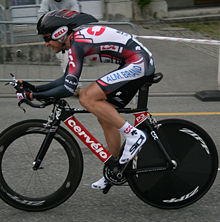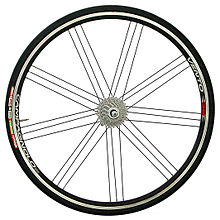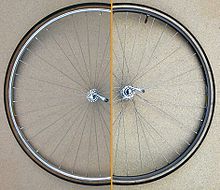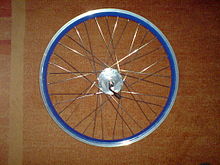Balance bike
A wheel is the entirety of a front or rear wheel on a bicycle . Sometimes a wheel is colloquially referred to as a rim or tire , although these are only parts of the wheel . Exactly which parts the term “impeller” includes is not clearly defined and depends on external circumstances. In operation, ie in the race, the term always describes a complete and ready-to-use wheel. When buying wheels, these are usually delivered without tires and tubes , but with rim tape , without a sprocket pack and brake disc. All wheels of a bicycle together are called "wheelset" (LRS).
Designs
Classic balance bike
A classic wheel is a spoked wheel , the individual parts of which are all standardized. As a result, components from different manufacturers can easily be used when assembling an impeller. All parts are available individually so that defective parts can easily be replaced. Plus, all tools are easy to get hold of. A classic balance bike consists of:
- Rim ,
- Spokes and nipples ,
- possibly washers for the spoke heads,
- Hub , on the rear wheel with freewheel body
- Axle , often in the form of a quick release or a thru axle ,
- Tires with jacket (also called cover), tube and rim tape or (for tubular tires) tires and rim adhesive (mostly tire putty , formerly tar tape ),
- one or more chain sprockets (only on the rear wheel) and
- possibly a brake disc .
The number of spokes depends on the price of the wheel and the intended use. Most common are wheels with 36 spokes, wheels with 32 spokes can also be found on the less heavily loaded front wheel. Modern mountain bike wheels sometimes have 32 or 28 spokes at the front and rear. In the past in particular, tandem wheels with 40 or 48 spokes were widespread; with modern components, 36 spokes are usually sufficient. To reduce weight and improve aerodynamics, racing bikes often have significantly fewer than 36 spokes; wheels with only 12 spokes are possible on the front wheel.
Classic 36-hole rims are rarely used for training wheelsets on racing bikes. In cycling , 28-hole rims were used almost exclusively until the 1990s. In track cycling, however, the 36-hole rim was standard until it was replaced by other types.
Classic balance bike with straight spokes
A deviation from the classic wheel is one with straight, uncranked spokes. Appropriate hubs and spokes are required for assembly, the rim and all other components do not differ. The advantage is that the hubs for straight spokes are lighter and there is no bending load on the spoke arch. Matching hubs and spokes are available from different manufacturers so that defects can be repaired. Depending on the hub type, radial and tangential (crossed) spokes with straight spokes are possible. The spokes are often designed as aero or knife spokes; To turn the nipple during tensioning, the spoke must be held against the flattened aero profile with a special tool, otherwise only the entire spoke in the hub rotates and no tension is built up on the nipple thread.
System impeller
In the case of system wheels, individual manufacturers are changing the individual parts and construction methods of wheels. Tires, tubes and rim tape correspond to those of classic wheels to ensure selection and interchangeability.
In particular, spokes installed “the other way round” are widespread, i.e. with the spoke nipples on the hub instead of the rim. This reduces the wheel's moment of inertia and the air resistance, as the nipples on the hub, which are somewhat heavier than the spoke head, have a lower rotational speed. Such spokes are often straight throughout instead of with an angled spoke head. The cross-sectional profile of the central part of the spokes of racing bike wheels is usually oval or narrow diamond-shaped in order to reduce air resistance ("knife spokes"). The number of spokes can be reduced by coordinating the individual components; sometimes only 12 spokes are used in the front wheel. The spokes are usually made of solid steel, more rarely aluminum alloys and only very occasionally, for example on expensive competition wheels , from plastics reinforced with carbon or aramid fibers (Kevlar). In addition to aluminum, carbon fiber reinforced plastic (“carbon”) is increasingly being used as rim material.
The advantages of lower air resistance only become relevant and measurable from around 40 km / h and thus only in professional racing use; the advantages of a lower mass moment of inertia show through more efficient acceleration. In practice, system wheels are only beneficial in high-performance sport, where they are no longer often used due to the lower stability of the asymmetrical lacing.
The disadvantage of system wheels is that spare parts (apart from tires, tubes and rim tape) are difficult or impossible to obtain because they are not standardized or commercially available components. Impeller repairs are therefore often only possible by the manufacturer.
For many years, Campagnolo's 12-spoke Shamal wheel had the least number of spokes.
Disc wheel

Disc wheels are specially made for time trials and track cycling . These reduce air resistance and turbulence. According to measurements in the wind tunnel, they save around 15 watts of power compared to normal 36-spoke wheels at a speed of 40 km / h. These wheels also have a tough rolling behavior.
Originally, disc wheels consisted of spoked wheels covered with foil, later the covers were made of stronger plastics. The current versions are mainly laminated from canvas-bound GRP or CFRP . In this way, the disc takes over the function of the spokes (power transmission, lateral stiffness). Disc wheels weigh between 1300 g (for inexpensive wheels) and 1000 g. With the world's lightest series disc Lightweight , 900 g were realized by the rovings (carbon fiber bundles ) only lying in the loaded directions. Disc wheels are very sensitive to cross winds, which can lead to dangerous situations, especially on the front wheel. In cross winds that come from behind at an angle of 60 °, however, disc wheels act like a sail and can thus generate additional propulsion. However, if the crosswind comes from the front at an angle of 60 °, a considerable braking effect occurs. Because they act as a resonance body due to their closed construction, disc wheels can develop a lot of running noises on poor ground. They are mainly used at the rear and are only approved for time trial in UCI competitions. For safety reasons, disc wheels on the front wheel are mostly forbidden in UCI races.
Special forms
Triple accumulators are running wheels with three spokes. The aerodynamics are not quite as good as with the disc wheel, but triple-storage systems are not susceptible to cross winds. Three storages are often used as the front wheel in time trials . They are basically part of the system wheels, as they do not consist of standardized parts.
In simple mountain bikes and children's bikes, balance bikes are sometimes used, which are made from one piece of plastic. This type of construction has mainly financial aspects. Such impellers cannot be repaired and can be found in the cheap range.
size
Impellers are manufactured in different sizes, depending on the purpose and tradition.
Lacing
The basic step in assembling a wheel is to connect the hub and rim with the spokes, known as lacing . There are different designs, depending on the use of the wheel and the taste of the wheel builder.
By far the most widespread is the tangential lacing, in which the spokes are inclined in the wheel. Due to the inclined position, the spokes can transmit torque, which is important if the wheel is driven or has a brake in or on the hub (drum, roller or disc brake). In order for the wheel to be inherently stable, the spokes must alternately be inclined to the front and back, which results in a crossover of the spokes. The more obliquely the spokes extend from the hub, the more torque they can transmit and the more spokes cross each other. However, a greater inclination also means longer spokes and thus a higher wheel mass. The most common is the triple crossing because it can be used for wheels with 24 to 36 spokes and already transmits a very high torque. The greatest torque can be transmitted when the spokes come off the hub tangentially to the flange. This is the case with 24 spokes with the triple, with 36 spokes with the four-way crossing and with 40 spokes with the five-way crossing.
The smaller the rim diameter or the larger the hub diameter (so-called high flange hubs), the more inclined are the spokes with otherwise the same geometry. Since the spoke curvatures are right-angled, the more such values change, the more the spokes are bent. Only in the theoretical case of a hub width of almost zero are the spokes without tension in their 90 ° bend.
With radial lacing, the spokes run straight from the hub to the rim. The advantage lies in the short spoke length and the correspondingly low mass of the wheel as well as a slightly higher lateral stiffness. However, the hub flange is more heavily loaded. Therefore not all hubs are approved for this lacing method. Because no torques can be transmitted, radial spokes are only suitable for non-driven wheels without a brake in or on the hub. It is widespread on front racing bike wheels.
Special spokes are rarer, like the Campagnolo wheel shown at the top of this article. Some special spokes are only used for aesthetic purposes, others are intended to improve function. Occasionally, when the impeller is driven, the sprocket side is spoked tangentially, while the opposite side is spoked radially, or vice versa (so-called Kildemoes spoking). Some special spokes lead to a heavy load on the hub flange, so that they only make sense with certain hubs. The special lacing also includes methods of connecting hubs and rims with a different number of spoke holes.
The spoke length is calculated as follows:
- L = spoke length
- s = width of hub flange
- D i = inner rim diameter
- d = diameter of hub flange
- n k = number of crossings
- n s = number of spokes
literature
- Gerd Schraner: The art of wheel building. 5th revised edition, Licorne-Verlag, Bern, 2010, ISBN 3-85654-101-2
Web links
- Wheel building , Sheldon Brown
- ADFC technical committee - lacing and centering
- Balance bikes , Smolik Velotech
- Lacing and centering , Fahrradmonteur.de
- Pictures of special lacing (in English)
Individual evidence
- ↑ Michael Gressmann: Bicycle Physics and Biomechanics. ISBN 3-89595-023-8
- ↑ Increased spoke breakage rate in high flange hubs in Smolik Velotech
- ↑ Special lacing in Smolik Velotech






